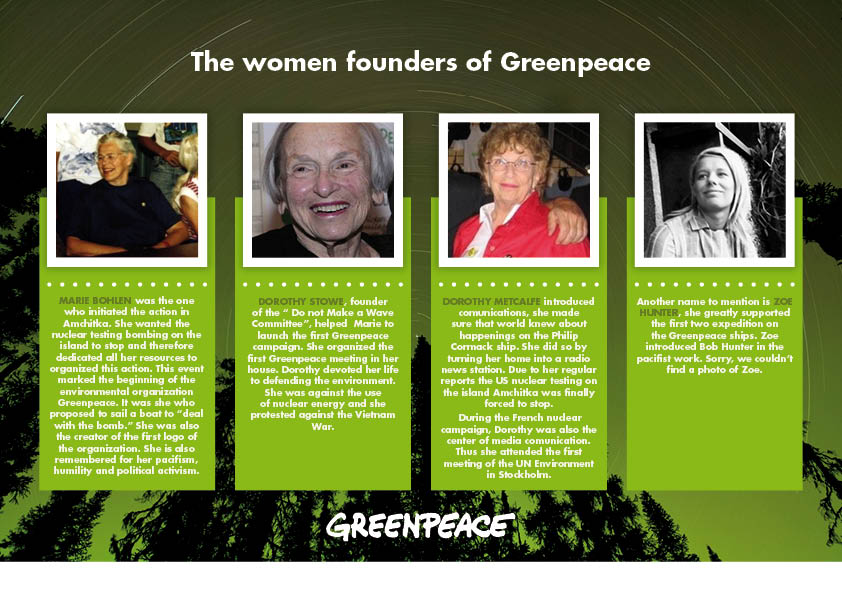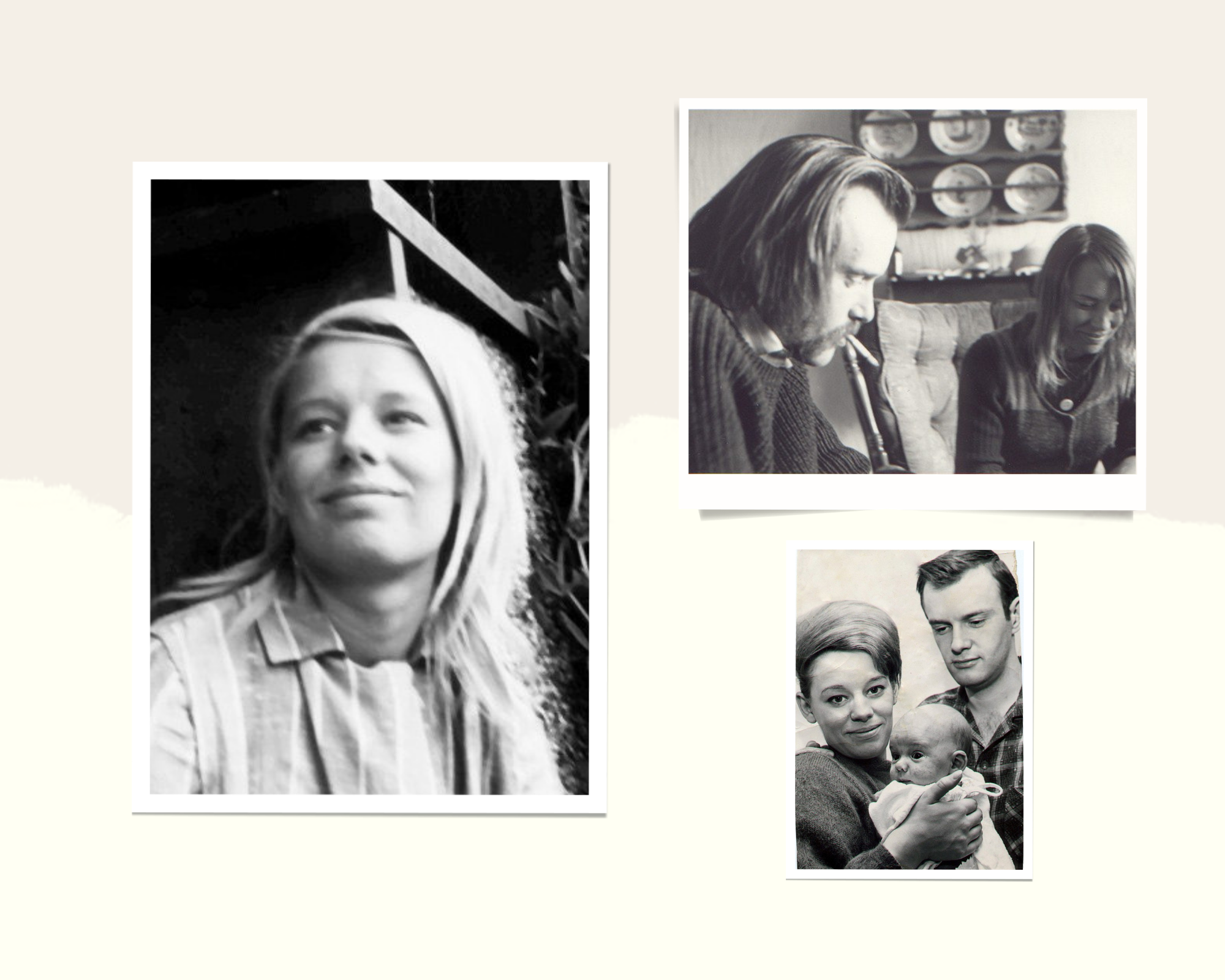El reconocimiento necesario a las fundadoras de Greenpeace
Este año se celebra el 50 aniversario de la fundación de Greenpeace. Medio siglo de historia, que tras un año de trabajo previo y recaudación de fondos, comienza con una acción, la emprendida con una embarcación que intentó impedir las pruebas nucleares que Estados Unidos estaba realizando en el archipiélago de Amchitka, Alaska. Esta primera acción estuvo protagonizada por cinco hombres, Ben Metcalfe, Jim Bohlen, Irving Stowe, Bob Hunter y Paul Cote, pero también por cuatro mujeres, Dorothy Metcalfe, Mary Bohlen, Dorothy Stowe y Zoe Hunter, quienes, hasta hace apenas unos años, habían permanecido olvidadas en esta historia.
Fue en el año 2014 cuando la Directora Ejecutiva de Greenpeace Canadá informó sobre el fallecimiento de Marie Bohlen, a la que reconocía como una de las co-fundadoras del “Don´t Make a Wave Committee”, lo que posteriormente sería Greenpeace. Fue en ese momento, cuando en el equipo de género de Greenpeace España comenzaron a preguntarse quién era Marie Bohlen y por qué nunca antes habían oído hablar de las fundadoras. De este modo, iniciaron una serie de investigaciones que tenían como objetivo conocer la verdadera historia, así como visibilizar a estas cuatro mujeres sin cuyo trabajo, seguramente, Greenpeace no sería la misma organización que hoy conocemos. Con esfuerzo, se pudo conseguir información de todas ellas, fotografías también, menos de Zoe Hunter, cuya imagen ha permanecido en blanco en todas las informaciones sobre las fundadoras.

Y aquí surge la historia de nuestra protagonista, Maribel García Expósito, una compañera voluntaria del Grupo Local de Tenerife, quien movida por un sentimiento de justicia y “ante el clamoroso hueco vacío en el poster de las fundadoras de Greenpeace y en el resto de fotografías del grupo primigenio” se puso a investigar, en esos ratos en que sus actividades como voluntaria, no sólo de Greenpeace, sino también en los campamentos de migrantes tinerfeños, se lo permitían, para conseguir la imagen de Zoe Hunter y que, todas nosotras, pudiéramos tener la fotografía completa de las fundadoras.
Maribel comenzó, como era lógico, realizando una extensa búsqueda primero por google y después por Greenpeace Canadá, pero no obtuvo ningún resultado, como si esa dificultad a la hora de encontrar una simple imagen, simbolizara tantos años de invisibilidad de la mujer a lo largo de la historia. Sin embargo, nuestra protagonista tenía la clave para poder tener éxito en esta búsqueda, sus vínculos con Canadá.
También en el año 2014, Maribel realizó su tesis doctoral sobre la perspectiva de género en la prensa de ese país, concretamente en los dos periódicos nacionales de más tirada, el Toronto Star y el Globe and Mail, “El género en la prensa diaria nacional canadiense: un análisis de The globe and Mail y The Toronto Star”. La costumbre de Maribel es seguir leyendo estos dos diarios y recordó haber leído, hacía ya algún tiempo, un artículo en el Globe and Mail, en el que se hablaba de Greenpeace y de cómo una de las hijas de los fundadores se había reconciliado con su padre en un acto conmemorativo, diez años después de la muerte de éste. Maribel encontró el artículo y resultó que la hija en cuestión, periodista de ese mismo diario, era Justine Hunter, la hija de Bob y Zoe Hunter. Tras realizar una búsqueda por la web del periódico, dio con su contacto y, sin pensarlo dos veces, le escribió con la esperanza de establecer contacto con ella y pedirle una fotografía de su madre.
Tan sólo unas horas después, Justine respondía a Maribel, agradeciendo el interés mostrado por su madre y por las co-fundadoras de Greenpeace y añadiendo estas palabras: “my mom and so many women were part of the origins of Greenpeace but rarely were recognized at the time. The first sailing to Amchitka was an all-male crew, but there were many people behind the scenes - Mary Bohlen and Dorothy Stowe are definitely part of that history, and others such as Kimiko Bruce, Linda Gannon and my mom…” (mi madre y otras muchas mujeres fueron parte de los orígenes de Greenpeace pero raramente fueron reconocidas en aquel momento. El primer viaje a Amchitka fue una tripulación de hombres, pero hubo mucha gente entre bastidores - Mary Bohlen y Dorothy Stone definitivamente fueron parte de esa historia y muchas otras, como mi madre, Kimiko Bruce, Linda Gannon...), estás últimas desconocidas aún y de las que, sin duda, deberemos comenzar a investigar. Asimismo, Justine remitió a Maribel a consultar algunos artículos, publicados en Canadá, y que hablaban sobre estas mujeres.

Como punto final he de decir que Justine envió tres maravillosas fotos de Zoe Hunter, en las que aparece junto con su compañero, Bob Hunter, y su hija, Justine. Unas fotos que Maribel enseguida compartió en el Grupo Violeta estatal y que todas nosotras recibimos con una grandísima alegría, ya que, tras cincuenta años de historia, podíamos poner cara a esa figura oculta, tan simbólica para todas aquellas mujeres, trabajadoras y voluntarias que han formado parte activa en la fundación y desarrollo de Greenpeace, y completar, de este modo, el póster de las fundadoras.
Sin miedo a equivocarme, en nombre de todas las compañeras, agradezco enormemente a Maribel el haber tenido esta iniciativa, que tan maravilloso resultado ha tenido, y que nos lleva a preguntarnos, una vez más, si todavía existe alguna persona que crea que incidir en la perspectiva de género y en el ecofeminismo no es esencial, incluso en nuestros días.
Protagonistas de la Historia: Zoe Hunter (una de las fundadoras de Greenpeace), Justine Hunter (periodista del Globe and Mail e hija de Bob and Zoe Hunter), Maribel García Expósito (Voluntaria de Greenpeace, integrante del Grupo Violeta Estatal) y el Equipo de Género de Greenpeace España.
Redacción del Blog: Cristina Campos Muñoz (Voluntaria de Greenpeace, integrante del Grupo Violeta Estatal y de Madrid)
Artículos citados:
https://www.theglobeandmail.com/news/national/greenpeace/article25016568/
https://vancouversun.com/news/local-news/canada-150/canada-150-the-couples-that-founded-greenpeace
https://www.mykeeper.com/profile/LindaGannon/
---------- English Version ----------
REDISCOVERING GREENPEACE’S ORIGINS 50 YEARS LATER
The necessary recognition to Greenpeace’s founder women
This year marks the 50th anniversary of the founding of Greenpeace. Half a century of history, which after a year of previous work and fundraising, begins with an action, the one undertaken with a boat that tried to prevent the nuclear tests that the United States was carrying out in the Amchitka archipelago, Alaska. This first action was carried out by five men, Ben Metcalfe, Jim Bohlen, Irving Stowe, Bob Hunter and Paul Cote, but also by four women, Dorothy Metcalfe, Mary Bohlen, Dorothy Stowe and Zoe Hunter, who, until just a few years ago, they had remained forgotten in this story.
It was in 2014 when the Executive Director of Greenpeace Canada reported on the death of Marie Bohlen, whom she recognized as one of the founder women of the “Don´t Make a Wave Committee”, which would later become Greenpeace. It was at that moment that the Greenpeace Spain gender team began to wonder who Marie Bohlen was and why they had never heard of the founder women before. In this way, they began some investigations aimed to know the true story, as well as to make visible these four women without whose work, surely, Greenpeace would not be the same organization that we know today. With effort, it was possible to obtain information on all of them, photographs also, except for Zoe Hunter, whose image has remained blank in all the information about the founder women.

And here comes the story of our protagonist, Maribel García Exposito, a volunteer of Greenpeace's Tenerife Local Group, who moved by a feeling of justice and "in the face of the clamorous empty hole in the poster of Greenpeace's founder women and in the rest of the photographs of the original group ”she began to investigate, in those moments in which her activities as a volunteer, not only with Greenpeace, but also in the Tenerife migrant camps, allowed her to do so, with the aim to get the image of Zoe Hunter and that, all of us, we could have the complete photograph of the founder women.
Maribel began, of course, by conducting an extensive search first by Google and then by Greenpeace Canada, but didn't obtain any results, as if that difficulty in finding a simple image, symbolized so many years of invisibility of women throughout of history. However, our protagonist had the key to being able to succeed in this search, her ties to Canada.
Also in 2014, Maribel carried out her doctoral thesis on the gender perspective in the press of that country, specifically in the two national newspapers with the most circulation, the Toronto Star and the Globe and Mail, “Gender in the national daily press Canadian: an analysis of The globe and Mail and The Toronto Star”. Maribel's habit is to keep reading these two newspapers and she remembered reading, some time ago, an article in the Globe and Mail, in which they talked about Greenpeace and how one of the founders' daughters had reconciled with her father in a commemorative act, ten years after his death. Maribel found the article and it turned out that the daughter in question, a journalist for that same newspaper, was Justine Hunter, Bob and Zoe Hunter' s daughter. After conducting a search on the newspaper's website, she found her contact details and, without thinking twice, she wrote to Justine in the hope of establishing contact with her and asking for a photograph of her mother.
Just a few hours later, Justine responded to Maribel, thanking the interest shown for her mother and the Greenpeace founder women and adding these words: “my mom and so many women were part of the origins of Greenpeace but rarely were recognized at the time. The first sailing to Amchitka was an all-male crew, but there were many people behind the scenes - Mary Bohlen and Dorothy Stowe are definitely part of that history, and others such as Kimiko Bruce, Linda Gannon and my mom…” these last two still unknown and, without a doubt, we must begin to investigate. Likewise, Justine referred Maribel to consult some articles, published in Canada, and that spoke about these women.

As a final point I have to say that Justine sent three wonderful photos of Zoe Hunter, in which she appears together with her partner, Bob Hunter, and her daughter, Justine. Photos that Maribel immediately shared in the State Violet Group and that all of us received with great joy, since, after fifty years of history, we could put a face to that hidden figure, so symbolic for all those women, workers and volunteers who have taken active part in the founding and development of Greenpeace, completing the poster of the founder women.
Without fear of being wrong, on behalf of all the colleagues, I am very grateful to Maribel for having had this initiative, which has had such a wonderful result, and which leads us to ask ourselves, once again, if there is still someone who believes that to incise on gender perspective and ecofeminism is not essential, even in our days.
Main Characters of the Story: Zoe Hunter (one of Greenpeace’s founder women), Justine Hunter (Globe and Mail journalist and Bob and Zoe Hunter’s daughter), Maribel García Exposito (Greenpeace Volunteer, State Violet Group’s member) and the Gender Team of Greenpeace Spain.
Blog Writing: Cristina Campos Muñoz (Greenpeace Volunteer, State and Madrid Violet Group’s member)
Mentioned articles:
https://www.theglobeandmail.com/news/national/greenpeace/article25016568/
https://vancouversun.com/news/local-news/canada-150/canada-150-the-couples-that-founded-greenpeace
https://www.mykeeper.com/profile/LindaGannon/
